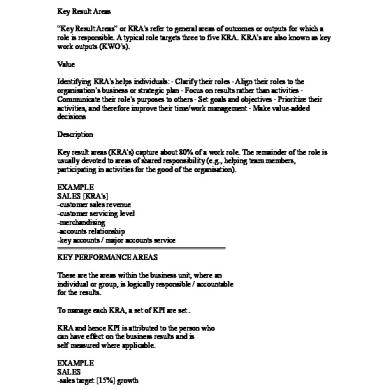Which Are Difference Between Static And Dynamic Analysis.docx
This document was uploaded by user and they confirmed that they have the permission to share it. If you are author or own the copyright of this book, please report to us by using this DMCA report form. Report DMCA
Overview
Download & View Which Are Difference Between Static And Dynamic Analysis.docx as PDF for free.
More details
- Words: 571
- Pages: 2
What are difference between static, quasi static, dynamic and transient analysis. Whether in dynamic and transient analysis need to use the inertia. Static and quasi static both refer to models where there is no dependency on time. Quasi static might be for a mechanism that is moving so slowly, that it is practically static. Both Dynamic and Transient analysis requires the material have a density so that acceleration loads on the mass of the bodies can be calculated. A Static analysis also needs material with density if you apply a gravity or acceleration load, but it doesn't need density if you are only applying forces. In a static problem, we assume acceleration is zero. Quasi-static means that at a given instant in time we can assume the problem is static. The fundamental assumption is that the loading is applied so slowly (very low frequency when compared to that of the structure) that basically the structure deforms in a static manner and inertia effects can be neglected. This assumption works well when inertial effects are very low. Also, this helps simplify the non-linear problems to a linear system. So, In static and quasi-static loading we are solving, F = KU and finding the displacements U (Neglect damping, inertia, K is the stiffness matrix) Note that a load quasi-static for a given structure (made of some material) may not be quasi-static for another structure (made of a different material) This is not the case in a dynamic analysis where inertia forces are not small enough to be neglected. Inertial forces result from Newton's second law (F = MA). So in a dynamic analysis, we need to account for the accelerations. Where MA is the inertial component and KU is the elastic component (assuming no damping). In dynamic loading we are solving, F = MA + KU + damping (again we are solving for the displacements in this equation) Hi every body. To be sure that is really quasi static problem you should compare eigenfrequency of you structure with frequency of loading. If eigenfrequency about ten times grate of loading frequency it may be a quasi static problem. In another way it is a dynamic problem.
Quasi-static load means the load is applied in slow rate like static load (very low strain rate). A dynamic load, causes a structure to vibrate and the inertia force is considered.
Loading types are dependable on many factors like time between each applied load.
-static load : Applying the load very slowly which means that stiffness forces of the structure (Force=Displacement * Stiffness) are governed not inertial forces ( Force = Mass * Acceleration ) as the load is applied very slowly acceleration =0
-Cyclic Loading : Applying the load more than once. If the the frequency of applying the load is small. --Quasi -Static: Loading could be Quasi-Static which means that there is acceleration of applying the load but it is very small and it can be neglected. Quasi- static means that there is dynamic effect but it is very small that leads to consider the system as if it is static but it is not.
-- Dynamic : If the cyclic loading is applied in quick manner and in a small duration. Inertial forces are induce. As the mass particles in the system move which means Newton Second Law of motion is validated. F=m*a addition force is induced additional to static load,
Quasi-static load means the load is applied in slow rate like static load (very low strain rate). A dynamic load, causes a structure to vibrate and the inertia force is considered.
Loading types are dependable on many factors like time between each applied load.
-static load : Applying the load very slowly which means that stiffness forces of the structure (Force=Displacement * Stiffness) are governed not inertial forces ( Force = Mass * Acceleration ) as the load is applied very slowly acceleration =0
-Cyclic Loading : Applying the load more than once. If the the frequency of applying the load is small. --Quasi -Static: Loading could be Quasi-Static which means that there is acceleration of applying the load but it is very small and it can be neglected. Quasi- static means that there is dynamic effect but it is very small that leads to consider the system as if it is static but it is not.
-- Dynamic : If the cyclic loading is applied in quick manner and in a small duration. Inertial forces are induce. As the mass particles in the system move which means Newton Second Law of motion is validated. F=m*a addition force is induced additional to static load,
Related Documents

Difference Basic And Dynamic Disk
April 2020 0
Difference Between Linux And Windows
November 2019 36
Difference Between Kra And Kpa
October 2019 23
Difference Between Gpa And Spa.pdf
May 2020 9
Difference Between Jit And Traditional
May 2020 9More Documents from ""

Trainings.docx
June 2020 2
Sapandstad.docx
May 2020 4
Aci Code.pdf
June 2020 13
Fin09-04 Skills Needs In The Energy Sector
May 2020 27
